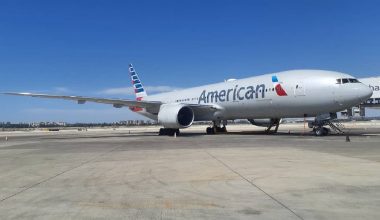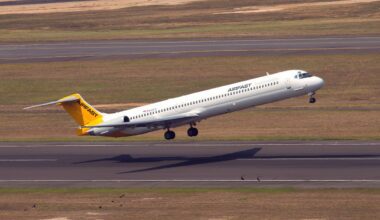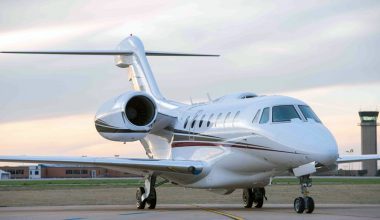Franco-British Aerospatiale/BAC Concorde is an aerodynamic masterpiece and supersonic marvel of the 20th century. The needle-nosed, slender-bodied, and ivory white jet seized the public’s imagination for its incredible speed and beauty of lines. Hailed as a technological wonder, Concorde could crack the sound barrier. The iconic Concorde jet could reach speeds over Mach 2.04, making it the fastest passenger jet ever built. The supersonic jet could make transatlantic crossings in mere hours thanks to its top speed of 2,354mph (2,179km/hr).

Concorde passengers could fly faster than the speed of sound from one city to another at the height of luxury. The aerospace marvel left behind a remarkable legacy of sheer speed that continues to inspire present commercial aviation.
In this article, we’ll discuss Concorde’s top speed and design technologies that allowed the jet to fly supersonic.
Before diving into Concorde top speed, let’s have a brief overview of Concorde.
Concorde jet
Concorde was a supersonic passenger jet built in a collaboration between British and French aerospace companies. Designed for the rich, the aircraft symbolized the pinnacle of luxury of air travel. The awe-inspiring airliner provided a blue riband service for the VIPs and celebrities alike and delivered silky-smooth junkets at supersonic speeds.

The Franco-British Concorde jet symbolizes cutting-edge technology and excellent engineering achievements of the last century. This outstanding work of architecture is one of the most beautiful airliners ever to grace the majestic skies. The tail-less aircraft boasted a futuristic design and supersonic capabilities that almost put other airliners to shame. It made its first commercial flight on 21 January 1976 and retired after 27 years of service in late 2003.
Concorde was the epitome of speed, typically cruising around 2,158 km/hr (1,165knots). The Anglo-Franco Concorde does not just demonstrate European technological prowess but symbolizes modern history’s incredible engineering feats.
Concorde top speed
Fitted with 4 Rolls-Royce/Snecma Olympus 593 engines, the Concorde could fly at speeds up to Mach 2.04. The Anglo-French turbojet enabled the airliner to achieve a supercruise of up to 1,354 mph (2,179 km/hr). Concorde top speed could beat the sound barrier by more than twice.
The supersonic passenger airliner pushed the speed limits and broke the time’s speed records. Concorde customers could enjoy a luxurious experience at twice the speed of sound for more than two hours.
Concorde could maintain speeds over Mach 2 at an altitude of 60,000 feet (18.3km). With the supersonic speed, the state-of-the-art Concorde jet made transatlantic journeys in less than 4 hours. Taking off at 220 knots, the world-famous jet would offer seamless transatlantic travel at a cruise speed of 1354 mph. The swift jet knocked off nearly half the flight time between the US and Europe and delivered jetlag-less journeys across the Atlantic.
In 1996, the Concorde jet made a speed record for traversing the trip from New York to London in an impressive 2 hours, 52 minutes, and 59 seconds.
Design technologies that made Concorde supersonic
1. Double delta wings
The mainstream commercial supersonic Concorde jet featured double delta (ogival-shaped) wings. The delta wing design offers unique aerodynamic characteristics and structural advantages conducive to high-altitude supersonic flight. Concorde’s delta wings were lighter than swept wings (of equivalent aspect ratio), which helped to reduce air resistance (also called drag).
At high supersonic speeds, a shock body beneath delta wings created an attached shockwave, resulting in high pressure. The high pressure associated with the shockwave provided substantial extra lift while not making too much drag.
2. Engine technology
The engineering marvel Concorde also owes its legendary supersonic abilities to the engines that powered it. It was equipped with four Rolls-Royce/Snecma Olympus 593 Mk610 turbojets directly to the underside of the wings.
Based on Rolls-Royce Olympus engines, these powerplants used reheats to produce maximum thrust. Afterburners would take the exhaust gases from initial engines and burn them again at takeoff by injecting additional fuel into the combustor. The afterburner technology increased thrust by burning fuel in Olympus 593 turbofan’s cold bypass air.

3. Reflective paint
The Anglo-French Concorde Mach 2 airliner sported highly reflective white paint for a reason. The white color on the outer surface of Concorde deflected the heat when traveling at supersonic speeds. Seemingly minor, the paint’s ability to deflect the heat augmented Concorde’s performance by preventing overheating.
4. Droop snoot
One of Concorde’s distinctive yet important design features was droop snoot. The moveable nose cone was lowered downward during takeoffs and landings for clear runway visibility. It was inclined upwards while flying at supersonic speeds, providing an aerodynamically smooth and streamlined shape to minimize resistance.
5. High-temperature alloy materials
The high cruising altitude made Concorde subject to high external temperatures and thermal expansion. The friction between the air and Concorde’s surface produced high temperatures, resulting in tremendous aerodynamic heating of its airframe. So, Concorde’s fuselage was made up of heat-resistant aluminum alloy to withstand elevated temperatures. The high-temperature alloy materials delivered excellent thermal stability, allowing the aircraft to maintain its structural integrity.
Political motivations behind the manufacturing of the Concorde jet
The supersonic Concorde jet was developed due to a joint effort between France and the United Kingdom. Both countries collaborated on Concorde development and production, aiming to assert their position as technological leaders and showcase their engineering capabilities and expertise.
Also Read: Boom Supersonic jet will require just 4 hrs to reach London from Dubai
They leveraged their respective technological advancements to push aviation technology to the forefront. By pioneering supersonic travel, both nations sought to establish themselves as self-reliant players in the aerospace industry. The flagship Concorde project demonstrated European aerospace manufacturers’ innovation and ability to compete with significant aviation players like the US, the Soviet Union, etc. Developing a supersonic airliner independently was seen as an effective way to reduce dependence on foreign manufacturers.
The Concorde jet symbolized national prestige and the status of France and the UK as significant leaders in the field of aviation.
Specifications of Concorde
Concorde is a tailless supersonic airliner featuring an Ogival delta wing, a droop nose, and analog fly-by-wire flight controls. Constructed out of aluminum, the narrowbody fuselage permitted a 4-abread seating for 92-128 passengers. The Concorde jet was 202 feet 4 inches long and 40 feet height. It had a maximum takeoff weight of 404,010 lb and a fuel capacity of 210,940 lb.

Concorde could fly non-stop across the Atlantic Ocean with an impressive supersonic range of 4,488.0 mi. The high-end clientele flying onboard Concorde could complete the transatlantic trip in around half the time compared to subsonic airliners. The route that took 8 hours for subsonic aircraft would take 3.5 hours for Concorde to serve it.
The demise of the Concorde jet
After 27 years of service, the remarkable engineering feat retired in 2003. Different factors, including high operational costs, economic downturns, and the high-profile crash of Air France 4590, led to decommissioning of the Concorde jet.
No supersonic successor to this day
It has been almost 20 years since the huge, delta-winged airliner forever bid goodbye to commercial aviation. In this period, no other aircraft has emerged to take over its supersonic transport role. In two decades since British Airways and Air France called time on Concorde operations, no aircraft manufacturers have succeeded in developing a supersonic successor to take Concorde’s place. Few near-supersonic aircraft are on the drawing board, but it’ll take time to get them into flying.
The well-established Bombardier Company has brought forward the concept of Global 8000. It is a flagship aircraft of a new era that will fly at a top speed of Mach 0.94-just under the speed of sound. Once the aircraft enters production, it’ll be the world’s fastest business jet since the Concorde. Using sustainable aviation fuel, Bombardier plans to overcome the near-supersonic barriers, i.e., huge emissions and fuel requirements. The Canadian Company is running crucial tests on the new plane and plans to bring it into service by 2025.
Also Read: Soon Aircraft with the Speed Greater Than Sound Will Become Airborne.
While the longest-range Global 800 business jet will still cruise under the speed of sound shortly, the whole industry is all eyes on Boom Overture. The Boom Overture is a proposed Mach 1.7 passenger supersonic aircraft powered by four x Boom Symphony medium-bypass turbofans. It has secured 15 orders from United Airlines and is planned to be introduced in 2029. Whether Boom Overture can serve the replacement role and fill the faster-than-a-bullet gap is yet to be seen.
Impact of Concorde’s Retirement on the Industry
Decommissioning this high-speed passenger jet was a retrograde step in commercial aviation. The retirement of Concorde meant losing its ambitious and disruptive speed capabilities that once changed the aviation landscape. The high-speed performance of Concorde and its relative success led people to speculate that the future of air travel was supersonic. When the BAe/Aerosptiale Concorde retired, the industry downgraded from having supersonic transport to mundane subsonic flying.






